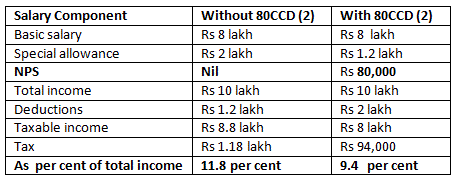
But to avail the benefit of this new tax-saving scheme you will need to ask your employer to make some changes to your CTC package.
We always encourage investors to make their tax saving investments in the beginning of financial year. Today we discuss National Pension Scheme wherein you can save additional tax in addition to Rs 1 lakh limit of Section 80C.
Let's first briefly have a look at National Pension Scheme (NPS):
About NPS
NPS is a defined contribution scheme regulated by an independent regulator called Pension Fund Regulatory and Development Authority (PFRDA). This scheme is available to the citizens of India (including NRIs) in the age group of 18 to 60 years.
It provides an active choice option to the participants wherein they can decide the manner in which their NPS money is to be invested i.e.in equity market instruments/fixed income instruments/government securities.
Though participants can decide to invest 100 per cent of their NPS money in fixed income instruments and government securities, investment in equity market instruments are restricted up to 50 per cent.
There is an 'auto choice' option available to participants who are not equipped with the required knowledge to manage their NPS investments. Under this option, the NPS money is invested in equity market instruments, fixed income instruments and government securities under a pre-defined portfolio depending on the age of the participant.
Courtesy: Investment-mantra.in

Two accounts under the NPS
The NPS follows two types of accounts: Tier-1 and Tier-2 accounts.
Withdrawals are not permitted from Tier-1 accounts during the vesting period except as per the norms prescribed by the PFRDA.
There are no restrictions on withdrawals from Tier-2 accounts.
An individual can open either a Tier-1 account or both. But Tier-2 account can be opened only if the subscriber already has a Tier-1 account.
The most notable feature of the NPS is the flexibility provided to the participants in respect of contributions made to these accounts.
The minimum contribution for Tier-1 account is Rs 6,000 per annum which can be contributed in as many installments as per the subscriber's choice with a minimum amount of Rs 500.
The Tier-2 account can be opened with a contribution of Rs 1,000 and the subscriber can make as many contributions of a minimum of Rs 250, provided the minimum balance in the account should not be less than Rs 2,000 at the end of every financial year.
In case the subscriber fails to maintain the minimum balance in Tier-2 account, a nominal penalty of Rs 100 will be levied for the same.

How NPS benefits in saving tax?
For majority of taxpayers, Rs 1 lakh tax-saving investment limit under Section 80 C is the only one which can be availed to save tax. The reason is very few employers/employees are aware of additional tax benefit which can be availed under Section 80CCD (2).
Under this section, up to 10 per cent of an employee's basic salary put in the New Pension Scheme is tax deductible.
This means a person with an annual basic salary of Rs 5 lakh (nearly Rs 40,000 a month) can get an additional deduction of Rs 50,000 if her/his employer puts this money on her/his behalf in the NPS.
Assuming that s/he will have other income (bonus, special allowance, interest, etc), which puts her/him in the 30 per cent tax bracket, the NPS investment under Section 80CCD (2) will reduce her/his tax liability by almost Rs 15,000.
Let's understand it with help of an example (see the adjacent table) that calculates tax-saving when annual basic salary is Rs 8 lakh and NPS contribution is Rs 80,000.
The table shows that Section 80CCD (2) helps cut an individual's tax by 24,000. This is besides the tax one saves under Section 80CC.

Employer needs to do investment on behalf of employee
This is one investment that a taxpayer can't make on her/his own. It is the employer who needs to deposit the amount on her/his behalf.
For this, the company has to be convinced to include the benefit in its emolument package.
Despite the enormous tax-saving potential of the provision, very few corporate houses have offered the benefit to their employees. There is little awareness about this clause. Not many people believe that their employees can save more tax through this avenue.

New lease of life for NPS?
This provision is also likely to inject new life into the moribund NPS. Government of India introduced the NPS for its employees in 2004 which was later extended to all citizens of India on a voluntary basis with effect from May 1, 2009.
Till now, the scheme has received a less than lukewarm response from voluntary investors, largely because distributors are not willing to sell the low-commission pension product. Even self-employed individuals can participate in the NPS.
The NPS is open to anyone between 18 and 60 years. Just as the PPF requires a minimum investment of Rs 500 a year, the Tier-I NPS account mandates a minimum annual contribution of Rs 6,000. However, unlike the PPF balance, this amount cannot be withdrawn from the NPS till the age of 60.
Even at that age, the investor will have to use at least 40 per cent of the corpus to purchase a life annuity, while the balance can be withdrawn.
The tax benefits under Section 80CCD (2) are available only on investments in Tier-I accounts. However, if you have a Tier-I account, you can also open a Tier-II NPS account.
Contributions to Tier-2 can be withdrawn without any restriction.

Conclusion
There is no comprehensive social security system in India as is available in developed countries. NPS provides an opportunity to the growing working class and self-employed individuals to arrange and provide for their old age requirements.
Providing additional tax benefit under Section 80CCD (2) is indeed is a welcome step and would encourage employers to extend the NPS benefit to its employees.
It is worthwhile to note that similar beneficial provisions are also contained in the proposed Direct Taxes Code (DTC) which is expected to be implemented from April 1, 2013.
If your company does not offer you this benefit yet, it's time to ask for it in your forthcoming appraisal.
In the highest 30 per cent tax bracket, it will enhance your increment by 3 per cent of your basic salary. All your employer needs to do is re-jig the salary structure by reducing any of the fully taxable emoluments (special allowance, performance-linked bonus, etc) and adding this new head in your total CTC.